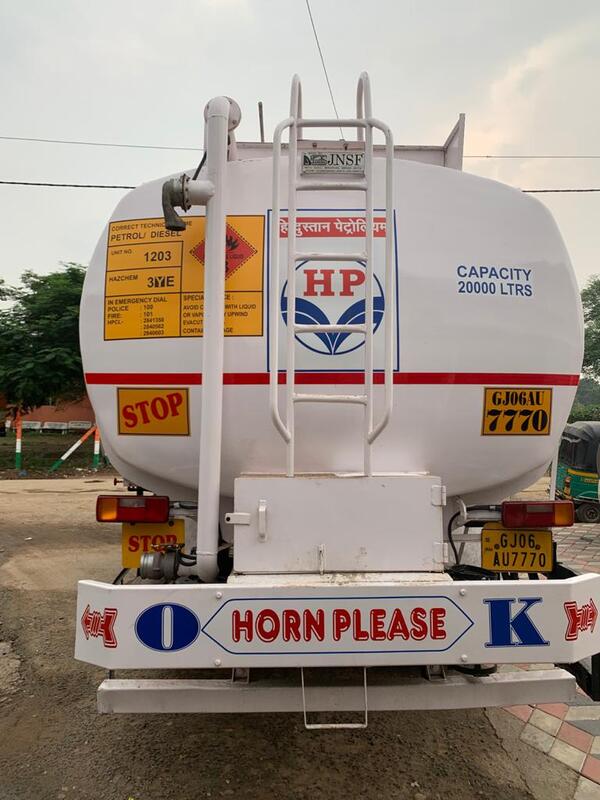#Bottom-Loading-Tanker-manufacturers #Petroleum-Tanker-manufacturers #Tanker-manufacturers #PESO-approved #JNSF-Industries A bottom loading tanker, also known as a bottom-loading tanker truck or simply a bottom loader, is a type of tanker truck used for the transportation of liquid products, such as petroleum, chemicals, and other bulk liquids. The main feature of a bottom loading tanker is the method by which the liquid is loaded into the tanker, which is through the bottom of the tanker rather than the top. Here are some key features and advantages of bottom loading tankers: Features of Bottom Loading Tankers: Bottom Loading System: Bottom loading tankers are equipped with a specialized loading system that allows for the loading of liquid products through the bottom of the tanker. This system typically includes a bottom loading arm, which is connected to a loading rack or terminal, and is inserted into the bottom loading connection of the tanker to transfer the liquid product. Multiple Loading Arms: Bottom loading tankers may have multiple loading arms, allowing for the simultaneous loading of multiple compartments or products. This can increase the efficiency and speed of the loading process, reducing loading times and improving overall productivity. Vapor Recovery System: Bottom loading tankers often include a vapor recovery system, which captures and recovers vapors emitted during the loading process. This can help reduce emissions of volatile organic compounds (VOCs) and other harmful gases into the atmosphere, improving environmental compliance and reducing air pollution. Safety Features: Bottom loading tankers are designed with various safety features, such as overfill protection devices, emergency shut-off valves, and grounding systems, to ensure safe and reliable loading operations. These safety features help prevent spills, leaks, and other accidents during the loading process, reducing the risk of environmental damage and worker injuries. Advantages of Bottom Loading Tankers: Faster Loading Times: Bottom loading tankers are typically faster to load compared to top-loading tankers, as the liquid product is loaded from the bottom directly into the compartments, allowing for quicker and more efficient loading operations. Reduced Risk of Accidents: Bottom loading tankers are designed with safety features that help reduce the risk of spills, leaks, and other accidents during the loading process. This can minimize the environmental impact and potential liability associated with product spills, and protect the safety of workers and the public. Improved Environmental Compliance: Bottom loading tankers with vapor recovery systems can help comply with environmental regulations by capturing and recovering vapors emitted during the loading process, reducing emissions of harmful gases into the atmosphere. Flexibility: Bottom loading tankers are versatile and can handle a wide range of liquid products, making them suitable for various industries, such as petroleum, chemical, and food and beverage. It's important to note that bottom loading tankers should be operated and maintained in accordance with industry standards, regulations, and best practices to ensure safe and efficient operations. Proper training and adherence to safety protocols are essential for the safe handling and transportation of liquid products using bottom loading tankers.
Chat with us on WhatsApp
×
This is your website preview.
Currently it only shows your basic business info. Start adding relevant business details such as description, images and products or services to gain your customers attention by using Boost 360 android app / iOS App / web portal.
#Bottom-Loading-Tanker-manufacturers #Petroleum...

2023-04-06T04:08:29
#Bottom-Loading-Tanker-manufacturers #Petroleum-Tanker-manufacturers #Tanker-manufacturers #PESO-approved #JNSF-Industries A bottom loading tanker, also known as a bottom-loading tanker truck or simply a bottom loader, is a type of tanker truck used for the transportation of liquid products, such as petroleum, chemicals, and other bulk liquids. The main feature of a bottom loading tanker is the method by which the liquid is loaded into the tanker, which is through the bottom of the tanker rather than the top. Here are some key features and advantages of bottom loading tankers: Features of Bottom Loading Tankers: Bottom Loading System: Bottom loading tankers are equipped with a specialized loading system that allows for the loading of liquid products through the bottom of the tanker. This system typically includes a bottom loading arm, which is connected to a loading rack or terminal, and is inserted into the bottom loading connection of the tanker to transfer the liquid product. Multiple Loading Arms: Bottom loading tankers may have multiple loading arms, allowing for the simultaneous loading of multiple compartments or products. This can increase the efficiency and speed of the loading process, reducing loading times and improving overall productivity. Vapor Recovery System: Bottom loading tankers often include a vapor recovery system, which captures and recovers vapors emitted during the loading process. This can help reduce emissions of volatile organic compounds (VOCs) and other harmful gases into the atmosphere, improving environmental compliance and reducing air pollution. Safety Features: Bottom loading tankers are designed with various safety features, such as overfill protection devices, emergency shut-off valves, and grounding systems, to ensure safe and reliable loading operations. These safety features help prevent spills, leaks, and other accidents during the loading process, reducing the risk of environmental damage and worker injuries. Advantages of Bottom Loading Tankers: Faster Loading Times: Bottom loading tankers are typically faster to load compared to top-loading tankers, as the liquid product is loaded from the bottom directly into the compartments, allowing for quicker and more efficient loading operations. Reduced Risk of Accidents: Bottom loading tankers are designed with safety features that help reduce the risk of spills, leaks, and other accidents during the loading process. This can minimize the environmental impact and potential liability associated with product spills, and protect the safety of workers and the public. Improved Environmental Compliance: Bottom loading tankers with vapor recovery systems can help comply with environmental regulations by capturing and recovering vapors emitted during the loading process, reducing emissions of harmful gases into the atmosphere. Flexibility: Bottom loading tankers are versatile and can handle a wide range of liquid products, making them suitable for various industries, such as petroleum, chemical, and food and beverage. It's important to note that bottom loading tankers should be operated and maintained in accordance with industry standards, regulations, and best practices to ensure safe and efficient operations. Proper training and adherence to safety protocols are essential for the safe handling and transportation of liquid products using bottom loading tankers.
2023-04-06T04:08:29
Keywords
- VOCs
- type
- food
- speed
- leaks
- vapors
- public
- method
- workers
- quicker
- products
- beverage
- terminal
- adherence
- emissions
- chemicals
- advantages
- atmosphere
- wide range
- accordance
- efficiency
- Flexibility
- loading rack
- key features
- Reduced Risk
- main feature
- PESO-approved
- bottom loader
- air pollution
- safe handling
- transportation
- liquid product
- best practices
- product spills
- Proper training
- loading process
- other accidents
- worker injuries
- JNSF-Industries
- safety protocols
- grounding systems
- industry standards
- various industries
- bottom loading arm
- other bulk liquids
- potential liability
- top-loading tankers
- other harmful gases
- overall productivity
- environmental impact
- environmental damage
- simultaneous loading
- efficient operations
- Faster Loading Times
- Vapor Recovery System
- Multiple Loading Arms
- Bottom Loading System
- multiple compartments
- bottom loading tankers
- various safety features
- environmental regulations
- bottom loading connection
- emergency shut-off valves
- specialized loading system
- volatile organic compounds
- bottom-loading tanker truck
- reliable loading operations
- overfill protection devices
- efficient loading operations
- Petroleum-Tanker-manufacturers
- Improved Environmental Compliance
- Bottom-Loading-Tanker-manufacturers

Submit Your Enquiry